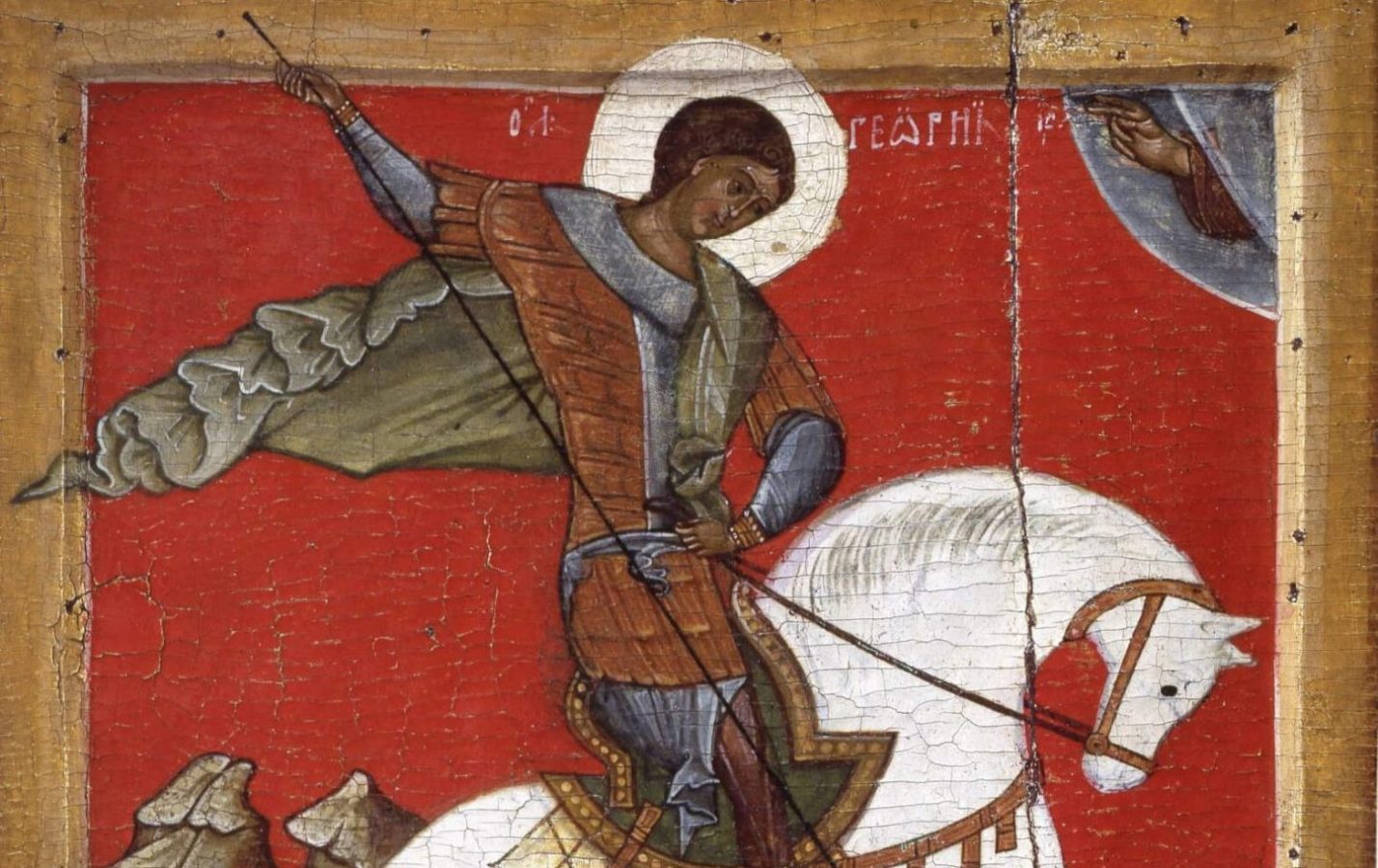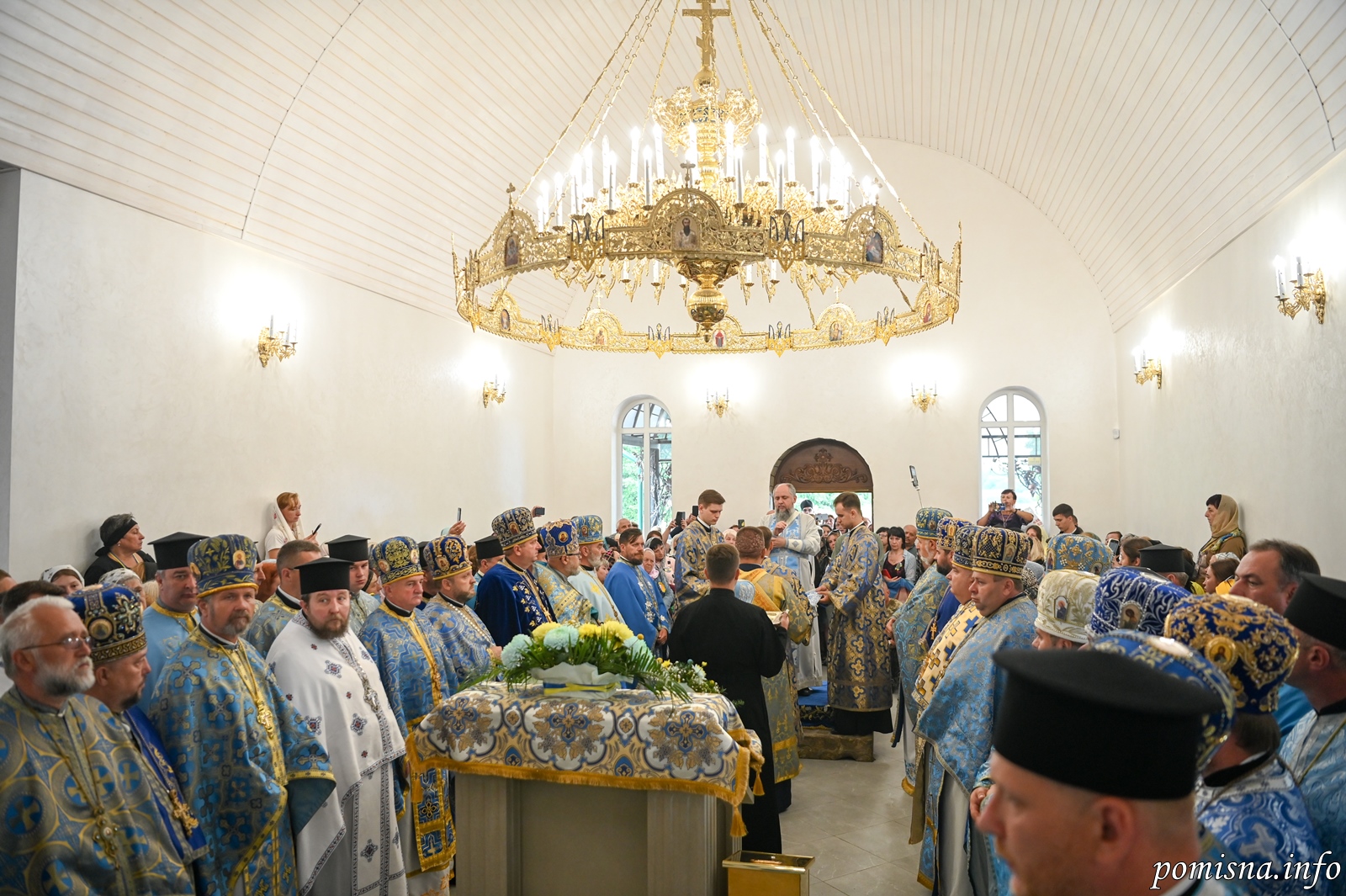The Life of St. George


“Wondrous is God in his saints” exclaims the holy psalmist David (Ps 68:36, LXX), and together with him we intone this sacred verse, especially when we consider the life of the holy and glorious Great-martyr George the Trophy-bearer, whom the mystical body of our Lord and Saviour Jesus Christ—the Orthodox Church—commemorates on the 23rd of April. Born around 280 AD, Saint George was a native of Cappadocia in Asia Minor. The son of well-to-do parents, his father reposed in the Lord when he was just ten years old. His mother was from Lydda in Palestine, and, after the death of her husband, travelled with the young George to her homeland because she had properties there.
God blessed George with wealth, comeliness, and bravery. At the age of eighteen, he enrolled himself in the legions of the Roman Empire and became a standard-bearer. This was a noted position, as the holder of the standard, which bore the emblem of the military unit, was meant to be very courageous: he was the rallying point for the troops in his unit, and was particularly exposed to attacks from opposing forces. George quickly advanced through the military ranks, enjoying the office of tribune and then commander. After he learnt of the repose of his mother in the Lord, he became the sole inheritor of her properties and even more dedicated to the army.
St George’s military prowess—his external bravery and skill against physical foes—can be seen as divinely inspired preparation for his internal bravery and his war against spiritual enemies. For while George belonged to a civilisation that was known for its exultation of heroes, warriors, and generals—and which prized material conquests and the worldly glory that they resulted in—the Christian faith to which he belonged was gradually changing the aspirations of people, especially young men and women. Instead of external battles and wars, Christians were to undertake spiritual warfare, as succinctly expressed by St Paul in his epistle to the Ephesians, 6:10-17:
Finally, be strong in the Lord and in his mighty power. Put on the full armour of God, so that you can take your stand against the devil’s schemes. For our struggle is not against flesh and blood, but against the rulers, against the authorities, against the powers of this dark world and against the spiritual forces of evil in the heavenly realms. Therefore put on the full armour of God, so that when the day of evil comes, you may be able to stand your ground, and after you have done everything, to stand. Stand firm then, with the belt of truth buckled around your waist, with the breastplate of righteousness in place, and with your feet fitted with the readiness that comes from the gospel of peace. In addition to all this, take up the shield of faith, with which you can extinguish all the flaming arrows of the evil one. Take the helmet of salvation and the sword of the Spirit, which is the word of God.
Here, St Paul interpreted military attire and weapons allegorically. No longer was armour to be used to defend against attacks from our neighbours of flesh and blood (to whom the Lord exhorts us to ‘turn the other cheek,’ cf. Matthew 5:39), but against the spiritual forces of evil, the demons and the devil. “The belt of truth, “the breastplate of righteousness,” “the shield of faith,” “the helmet of salvation,” and “the sword of the Spirit”: all these are the ‘military gear’ of Christians, protecting them from temptations in their journey towards salvation in Christ. St George was able to transfer the significance of physical armour and weapons to the spiritual warfare that he was called by providence to undertake, especially when he testified to the Gospel through sufferings in imitation of our Lord Jesus Christ. And just as he was a standard-bearer when he began his military career, so too would he become a rallying point for Christians who suffered and were killed under the pagan emperor Diocletian, who instigated the Great Persecution against the Church in AD 303. The burning of churches, sacred scriptures, and the martyrdoms that ensued were particularly frequent in the Eastern territories of the empire, under which St George’s homeland fell.
![]()
![]()
At the time that the Great Persecution began, St George was serving the military at York in Britain—the same place where the future Christian ruler, St Constantine the Great, would be declared emperor by his father’s troops just a few years later, in AD 306. In these Western territories of the empire, they were not so disposed to persecuting Christians. This could have been because Constantine’s father, Constantius Chlorus, governed these parts: his tolerance of the Church is well known. The governors of the Eastern territories, on the other hand, were overwhelmed by the edict to persecute, since Christians were found there in great numbers, and the martyrs many. They therefore implored Diocletian to put it to an end. Wishing to address this matter in council, Diocletian convened a meeting of the Roman elite where he resided, in Nicomedia in Bythinia. Here he was to press hard for the continuation of the persecution. Around the same time, George departed for Palestine, sold off his property and gave the profits, as well as the money he already possessed, to the poor. He manumitted his slaves, except for his friend Pasikrates, who chose to remain in his service.
Stripped of all worldly attachments and arrayed in the “armour of God” (Eph 6:11), George was prepared for the spiritual contest. Hearing about Diocletian’s council, he went to Nicomedia and faced the emperor, castigating him—in the presence of the Roman elite—for his idolatry and ruthlessness and exhorting him to embrace the faith in God the Trinity. Diocletian, who had regarded George highly, offered him a chance to show his fealty to the empire by sacrificing to its gods. When, like so many holy martyrs before him, St George refused to sacrifice because of his commitment to Christ, he was subjected to various tortures, the providential purpose of which was twofold: first, to manifest the saint’s loving self-sacrifice in imitation of Christ who died in behalf of sinners—even those who put him on the cross—and second; to show forth God’s glory, since the saint’s sufferings were healed by the Lord and were accompanied by miraculous signs. These signs included: suffering a spear wound just like the wound that Christ suffered when he was speared with a lance on the cross (John 19:34); being freed from a wheel covered in knives and miraculously healed of the wounds incurred thereupon; surviving immersion in a lime-pit for three days; being healed of wounds caused to his feet from red-hot iron shoes; incurring beatings and floggings so that his face shone like the sun, which is testified to in his icon (and the icons of all the saints) and indicates the presence of God’s grace; surviving the ingestion of poison; resurrecting a dead man just as Christ raised Lazarus (Jn 11:38-44), the young girl (Mt 9:18-22, Mark 5:35-43, Luke 8:40-56) or the widow’s son at Nain (Lk 7:11-17); and by prayer exposing the demons in the temple of Apollo and shattering the idols there present. The saint was finally decapitated, and it became clear that, throughout his martyrdom, he demonstrated with his patient endurance and reliance on Christ the wonders of God in his saints (Ps 68:36). He converted many to Christianity who were formerly pagans, including Diocletian’s wife, the empress Alexandra, and his life remains a compelling witness to the truth of Christianity even to this day.


St George was martyred in the Lord on 23rd April, AD 303. Fittingly, he is called ‘trophy-bearer’ because he has received the ultimate prize from the spiritual contest that he undertook, which is to be in the presence of our Lord and Saviour Jesus Christ forever and ever. Pasikrates took his holy body to his mother’s birthplace in Lydda, Palestine, according to the saint’s wishes. Here it worked miracles, and continues to do so; for the saint is a great intercessor to the Lord in our behalf. Since he dwells in the Lord, he continues to perform miracles by the power of Christ through his relics and icons that depict him authentically, as he was in life. Famous throughout the world, and the special patron of many cities and countries, St George has been encountered by many saints throughout the generations, and the Church continues to experience the benefits of his prayers, since, even now, he entreats our Lord Jesus Christ for our salvation.
Written by Dr Mario Baghos. First published on the website of the Holy Monastery of St George, Yellow Rock (https://www.stgeorgeyellowrock.org/articles




